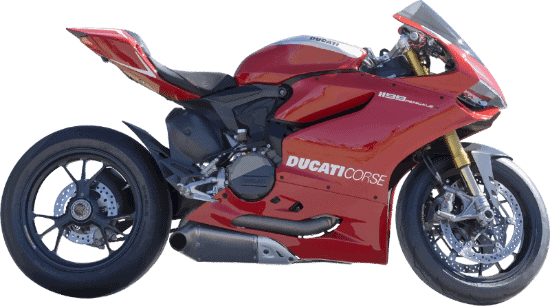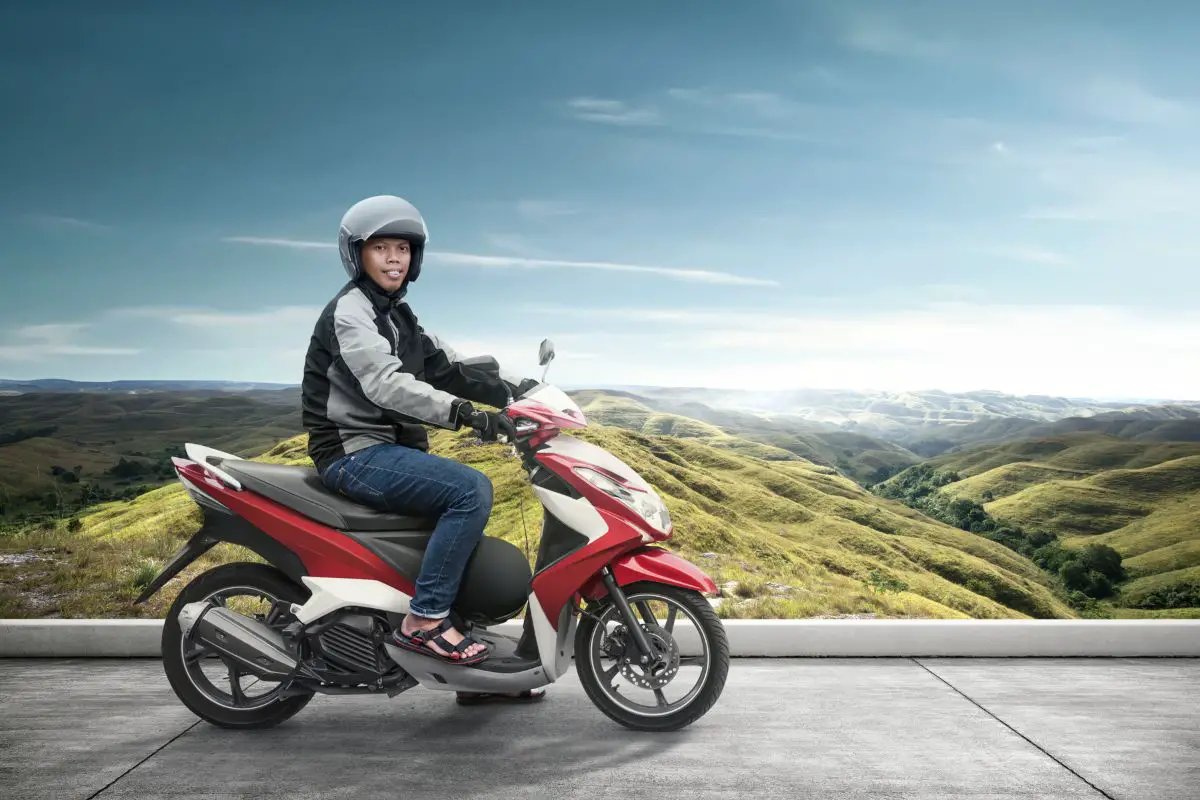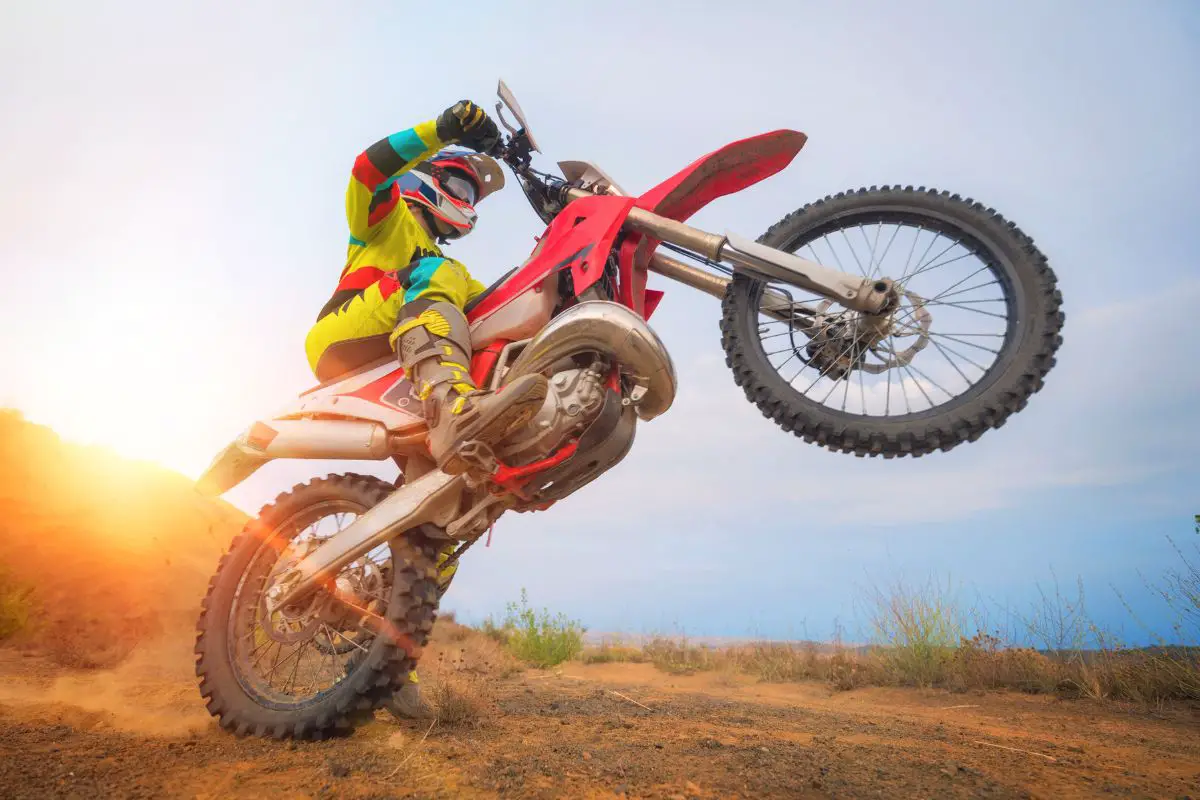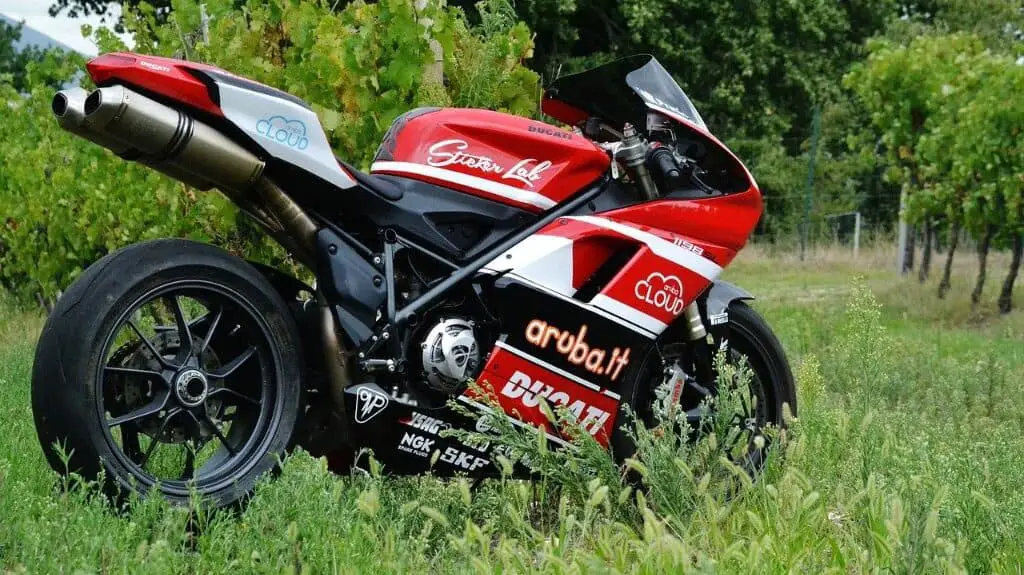
Within this article, I’m going to answer the question of what motorcycle fairings are and how they work. This might seem like an extremely complex question on the surface, but I’m going to break it down for you in easy to read chunks.
Whether you are thinking of purchasing your first motorcycle or thinking of customizing a motorcycle that you already own, this article will make crystal clear to you all of the basic information you need to make an informed and educated decision.
After all, motorcycle fairings not only increase the speed and fuel efficiency of your motorcycle. They also have the power to change the way a motorcycle handles when ridden, the looks of the bike, and how the rider is protected against the elements such as high winds and rain. If all of this seems new to you, be sure to read on to find out more!
So, What are motorcycle fairings?
Motorcycle fairings are the sleek outer shells of motorcycles typically made of plastic or fiberglass. When put together as complete sets, they form the coverings that encase the motorcycle’s inner workings and transform them into more aerodynamic machines. The fairings also help protect the rider against the elements and add styling to the motorcycle.
If you have ever wondered how racing and sport bikes have a distinct look compared to mopeds and scooters and travel at lightning speeds, obviously as well as the specially constructed engines, a large part of this is thanks to the fairings which have been attached to these motorcycles.
I want to thank the sponsors of this post-EMANUALONLINE. Using their service, you can download your motorcycle or car manual to your mobile phone or any other device, so you will have it handy should you ever be out and about and need to use it. You can visit their website by clicking the icon below and using the code BUDDY15 to get a 15% discount.
How important are the fairings on a motorcycle? Millions of dollars can be spent on designing and constructing the top sports bikes’ fairings, allowing the professional, super sports riders to race these bikes to their limits. This should indicate to you how important the fairings of a motorcycle are.
However, it is not just the racing enthusiasts that should consider applying new motorcycle fairings to their bikes. Those considering taking up long-distance traveling on touring or adventure motorcycles may not need to think too much about speed but need to bear in mind the conservation of the fuel used over long distances and the added comfort good fairings can bring a rider.
There is nothing worse than nearing the end of a memorable tour across the country, only to find the red fuel light flashing and your bike running on fumes, and you feeling exhausted. If a motorcycle is more aerodynamic, it will increase fuel efficiency and make long journeys less expensive and less tiring.

Motorcycle Fairings Protect The Bike
Another point worth thinking about is the protection afforded to the internal mechanisms of the motorcycle. If the engine or other motorcycle parts are exposed to the elements, this can leave them vulnerable to serious damage and corrosion. Under the worst circumstances, wind and water can damage your motorcycle’s internal components and render it unusable.
Therefore, it is important to protect your bike from depreciation and ensure that it is covered with good quality fairings. A final important factor to consider is the aesthetic one – a motorcycle does not look like a motorcycle without a set of high-quality good styled fairings.
In the same way that computers look strange without a case or a vending machine would appear out of place without a cover, a motorcycle needs its fairings to add color as well as a sleek shape.
If you’re looking to upgrade the fairings on a motorcycle you already own, then there are a wide variety of colors and designs to choose from. Choose very carefully, and do not rush your decision. Be sure to check the specifications, the weight, and important attributes before committing to a decision.
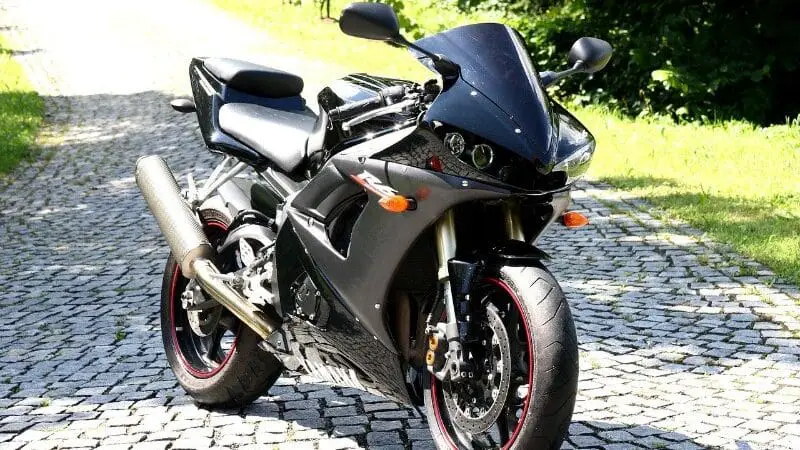
How do motorcycle fairings work?
The force that prevents a motorcyclist from traveling as fast as he or she would like is drag. As the motorcyclist is riding forward, the air flowing past them meets resistance both from the motorcyclist and the motorcycle. This generates the force known as drag, which pulls the motorcyclist in the opposite direction to the one he or she is heading in.
In turn, this slows the motorcyclist down and forces the bike to use more fuel to overcome the drag while accelerating and riding the motorcycle at a steady pace. Therefore, it is necessary to reduce this resistance by streamlining the surface of the motorcycle with fairings.
With fairings encasing the motorcycle, the air can move more freely past the motorcycle and the rider, making it easier for the motorcycle to accelerate and move forwards at speed.
The motorcyclist can now travel longer distances and at higher speeds. The
motorcycle’s cockpit also experiences an advantageous change when the positive effects of the fairings are realized. The air within the cockpit becomes more stable, and, as a result, the motorcyclist does not need to expend as much effort into staying in place on the motorcycle.
The bike’s rider can stay on their motorcycle for longer periods of time without having to take a break due to fatigue and benefits from a calmer and more enjoyable ride.
Whether it’s a sports bike, adventure bike, street bike, or any other type of motorcycle, the fairings all act to reduce air friction, protect the rider from the elements, and help the bike perform to the expectations of the rider no matter how different those expectations are.
Either on a race track cutting through the air offering the bike more speed or on a long-distance adventure touring motorcycle protecting the rider from the elements throughout a long journey.
How are fairings installed and removed?
Fairings are relatively easy to install and remove and require little mechanical or engineering experience. However, the important step to bear in mind is if you are replacing the fairings on a motorcycle, the correct sourcing of the motorcycle fairings is key.
If a set of fairings does not match the bike’s model precisely, it will take more effort to match the fairings to your particular motorcycle. This could be very time consuming and could end up being a complete waste of effort if the new fairings do not match your bike exactly. Therefore, it is highly recommended that you only use fairings that were either made by the manufacturer of your motorcycle or a set of independently made fairings from a specialist dealer.
Assuming you have the correct set of fairings, you can use a screwdriver or allen key to install each part from your set of fairings onto the motorcycle. You must follow the manufacturer’s guidance and instructions meticulously to avoid those unwanted mishaps. Take great care that each piece aligns neatly to the corresponding motorcycle part.
Removing motorcycle fairings is simply the same process but in reverse. Use your screwdriver or allen key to unscrew the bolts which adjoin the fairing piece to the motorcycle and remove it carefully. Although this might seem like a surprisingly simple process on the surface, it is important to consider precision when installing and removing motorcycle fairings.
In some cases it might be advisable to find a professionally qualified motorcycle mechanic to carry out the work.
Contact your local motorcycle store, and they may even install the fairings for you at a reasonable price or, perhaps, include it within the new fairings’ retail cost. This is especially important if you are using an independently made set of fairings. This way, you will have peace of mind that the fairings are properly secured and offer you the full extent of their advantages while riding.
What are the main types of fairings available?
There are three main types of motorcycle fairing available on the market:
- Full Fairings
- Half Fairings
- Quarter Fairings
- Handlebar Fairings
- Belly Pan Fairings
- Rear Fairings
These are often accompanied by two further types of fairing: handlebar and tail. The full, half, and quarter fairings concern the motorcycle’s main body to one extent or another.
For maximum protection against the elements such as wind or water and gain all the advantages of the aerodynamics a set of high-quality fairings offer, you might think the choice is obvious: the full fairing! It does, after all, fully cover the motorcycle and its internal mechanisms.
However, aesthetics and weight are two other considerations to take into account. Some may prefer a motorcycle that shows the intricate, metallic mechanical inner workings behind its awesome power. Others may be concerned that the full set of fairings’ additional weight will slow the motorcycle down by an unacceptable amount.
If either one or both, of these, are a factor, considering using a half or quarter fairing may be the answer:
Full Fairing
A Full fairing is a large front-mounted fairing covering both upper and lower parts of the motorcycle, as distinct from a half fairing, which only has an upper section covering the motorcycle, and leaves the lower half exposed. The fairing on a race or sports bike is meant to help aerodynamics, so the windscreen is rarely looked through.
If the rider is sitting up at speed he will be buffeted by his rapid progress through the air and act as a parachute, slowing the bike, while if the rider lies flat on the tank behind the windscreen he generates much less aerodynamic drag. The high windscreen and handlebar width of a touring fairing protect the upright rider from the worst of this air.
Full fairings can also provide protection to the engine and chassis in the event of a crash where the fairings, rather than the engine covers and/or frame, slide on the road.
Half Fairing
Half fairings usually feature a windscreen and extend below the handlebars, and could go as low as the cylinder block, but generally do not cover the sides of the crankcase or gearbox. Aftermarket lowering kits are available to extend some half fairings into full fairings.
Due to the popularity of these kits, some motorcycle manufacturers have started to supply their own full fairing conversion kits and sometimes offer their half faired models new with a full factory-fitted kit.
Quarter Fairing
Quarter fairings cover only the front of the motorcycle. A windscreen and minimal fairing extending around the headlamp which is fixed to an item on the front of the motorcycle called a triple clamp. Another name for this can be a cafe fairing or bikini fairing, which stops well below the level of the rider’s head, which relies on the air deflecting to protect the rider’s head and chest from the slipstream.
Handlebar Fairing
Handlebar fairings which can also be called headlight fairing or headlamp fairings are not fixed to the main chassis as with other types of fairings. A handlebar fairing complete with the screen is like an expanded and extended nacelle (a streamlined casing on the outside of a motor vehicle). It is attached only to the forks or yokes, covering the headlight and instrument panel, and different portions of the handlebars.
The handlebar fairing is able to move as the bars are turned.
Belly Pan Fairing
Quarter and half fairings are often paired with a belly pan below the engine for diverting airflow away from under the engine to reduce aerodynamic lift. They are often used for cosmetic reasons as well. Some track day or racing rules require belly pans to catch leaked fluids.
Rear/Tail Fairings
Rear/Tail fairings protect the rear of the motorcycle behind the motorcyclist. A tail fairing sometimes referred to as a tail unit or race tail, is mounted behind the seat and rider. Some can also extend to the sides of the saddle and even below, usually providing a small storage space.
On sports and race replica styled bikes with dual seats, detachable color-matched tail humps are also available which either cover the passenger seat or are exchanged for it. These blend in with the tail unit and side panels giving extra streamlining and the look of a single-seater racing bike.
What materials are motorcycle fairings made from?
Acrylonitrile butadiene styrene (ABS) plastic is commonly used in original equipment sport bikes and certain aftermarket fairing manufacturers due to its strong, flexible, and lightweight properties.
The advantage of this material over other plastics is that it combines the strength and rigidity of acrylonitrile and styrene with the toughness of polybutadiene rubber. The percentage of each property varies based on the desired result.
There are two common methods of producing an ABS plastic fairing: injection and compression molding.
- Injection molding: ABS plastic is melted and injected into mold cavity. Constant pressure is applied to allow for material shrinkage. The plastic then cools and hardens in the mold. Injection molds allows for uniform thickness throughout the entire piece. It gives the most accurate end product that fits well. It is how most manufacturers make their plastics.
- Compression molding: The plastic is generally preheated is placed into a heated metal mold cavity and pressure is applied to force the plastic to contract and take the shape of the mold. Heat and pressure is kept until the plastic cures the mold.
The excess plastic is cut away and removed from the mold. Disadvantages to compression mold include varying product consistency and flashing, which is excess material attached to the molded part that needs to be removed where two or more parts of the mold meet.
Fiberglass is made of woven fibers, and is used as a reinforcing agent for many polymer products. The composite properly known as glass-reinforced plastic (GRP), is normally referred to by the name of its reinforcing material. Fiberglass fairings are commonly used on the race track.
In most cases, fiberglass is lighter, and more durable than ABS Plastic. Damaged fiberglass can be repaired by applying new layers of woven fiberglass cloth mixed with a polymer such as epoxy over the damaged area, followed by sanding and finishing.
Carbon-fiber reinforced polymers the lightest, but most expensive, fairing material. It is used on the most extreme sport and racing motorcycle fairings.
Conclusion
If you are looking to purchase a new motorcycle, then pay careful consideration to the fairings which come with the bike. Are they going to be suitable for the type of riding you will be using the bike for?
If, however, you are looking to replace the fairings on a motorcycle you already own, you now have the comprehensive and extensive knowledge needed to make an informed choice as to what motorcycle fairing suits your needs!
Do not rush into things. Make sure to take your time and contact your motorcycle’s manufacturer if you have any doubts whatsoever. If you cannot find the original fairing set, your motorcycle manufacturer will be sure to help you.
If the bike is not manufactured anymore or the fairing is discontinued, this still should not be a problem. Get in touch with an experienced motorcycle specialist and describe your motorcycle’s exact specifications. You can send them photographs or a video as well as written details.
Remember, a set of fairings is only as good as the specification offered, so be precise! Check reviews thoroughly and take into consideration ratings and feedback from previous customers. This will ensure you are buying from or having the work carried out by a reputable business.
When you are satisfied that you have selected the right business, be sure to ask about installation. The specialists themselves will usually be able to offer it or, if not, your local motorcycle store may have a fairing installation service. If you have followed all of the advice written in this article, you will have a ride that your fellow bikers will be envious of!
Happy riding!
Source:

